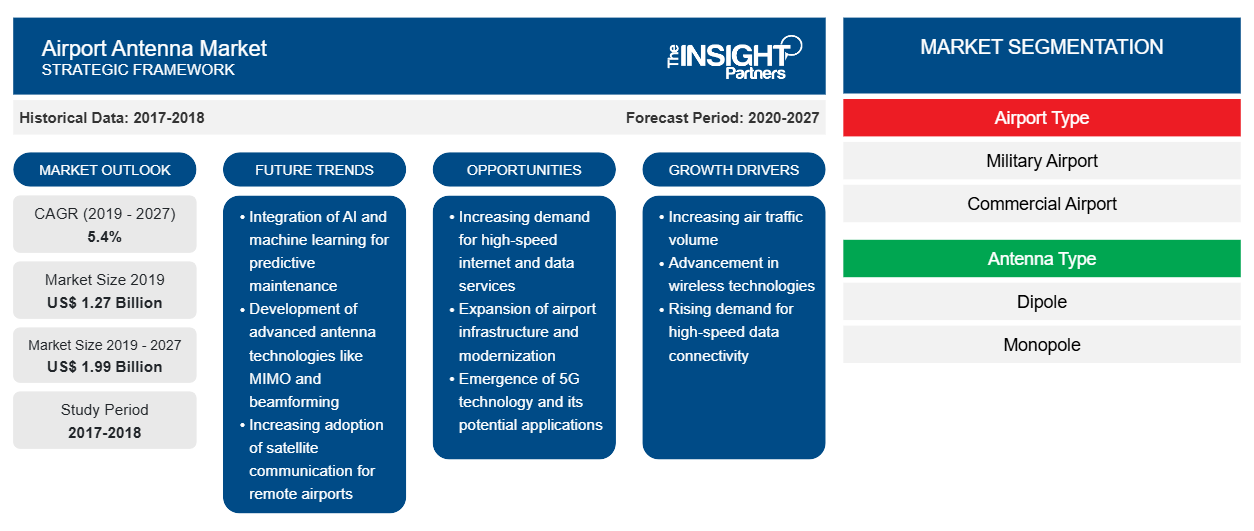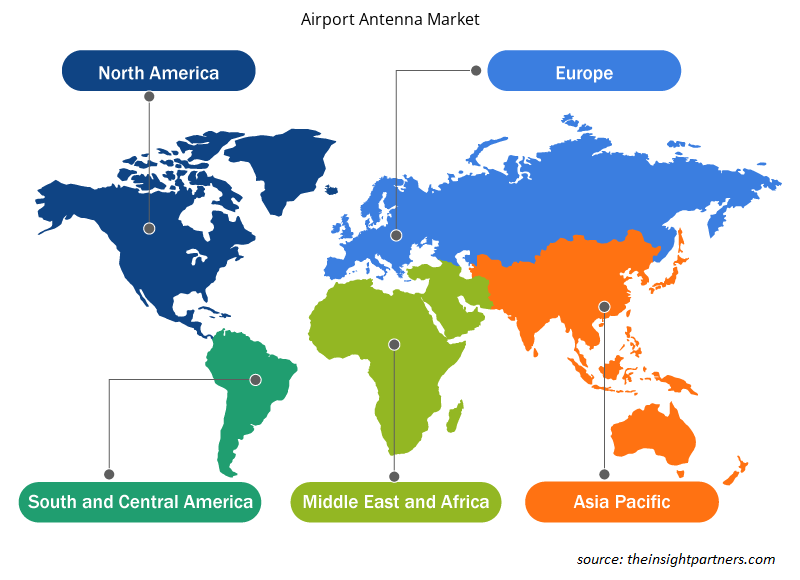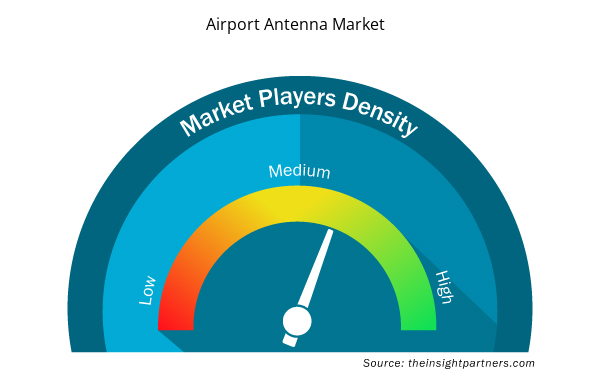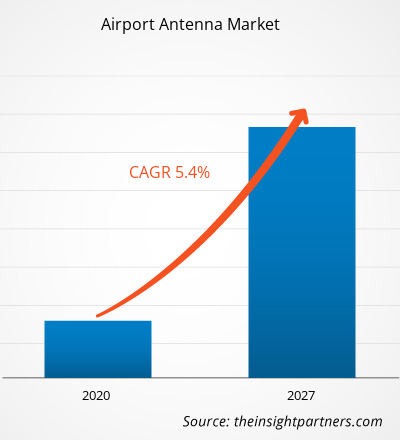The airport antenna market was valued at US$ 1.27 billion in 2019 and is projected to reach US$ 1.99 billion by 2027; it is expected to grow at a CAGR of 5.4% during the forecast period.
An antenna is a device that receives and transmits electrical signals. Antennas play an important role in airports to facilitate mobile telephony, satellite communication, and wireless local area networks. An aircraft uses radio frequency antennas to navigate their destinations and communicate with air traffic control. Airport antennas are mainly used for military airports and commercial airports. In military airports, the antennas enable enhanced communication by introducing high frequency, very high frequency, and ultra-high frequency bands. These advanced antenna solutions provide vehicular, ground-based, airborne, and shipboard applications that helps exhibit multiple military operations.
The advancements in airport antenna systems are increasing owing to the rising construction and renovation of new and existing airports across the world. As the number of passengers travelling through flights is increasing, there is a huge deployment of wireless LAN Wi-Fi hotspot antennas in airports to provide high speed internet access to the passengers. The Mobile Mark, Inc., a UK-based company, in October 2019, offered 5G fleet management antennas for Global Navigation Satellite System (GNSS) and Wi-Fi facilities that would be used for communication, public safety, and vehicle fleet management.
Customize This Report To Suit Your Requirement
You will get customization on any report - free of charge - including parts of this report, or country-level analysis, Excel Data pack, as well as avail great offers and discounts for start-ups & universities
Airport Antenna Market: Strategic Insights

- Get Top Key Market Trends of this report.This FREE sample will include data analysis, ranging from market trends to estimates and forecasts.
You will get customization on any report - free of charge - including parts of this report, or country-level analysis, Excel Data pack, as well as avail great offers and discounts for start-ups & universities
Airport Antenna Market: Strategic Insights

- Get Top Key Market Trends of this report.This FREE sample will include data analysis, ranging from market trends to estimates and forecasts.
Impact of COVID-19 Pandemic on Airport Antenna Market
The global aviation industry is one of the major industries facing serious disruptions such as flight cancellations, temporary country lockdowns, and reduction in passenger numbers, as a result of COVID-19 pandemic. According to International Civil Aviation Organization (ICAO), in 2020, there is ~57%–60% decline in number of passengers compared to 2019 and ~US$ 256 billion passenger revenue loss from January to august 2020. Subsequently, plummeting the demand for improvement of airport infrastructure development including the demand for airport antennas globally. Moreover, the lockdown of various plants and factories that develop components, sensors, controller, and material for antennas in leading regions such as North America, Europe, the Middle East and Africa, and South America is affecting the global supply chains and negatively impacting the developments in airports, establishment of new airports, and raw materials.
Airport Antenna Market Insights
Surge in development as well as modernization of airport infrastructure
The Governments of different countries are focusing on enhancing airport infrastructure, owing to the growing number of air passengers across the world. According to the International Air Transport Association (IATA) 20-year estimations, the number of global air passengers is expected to reach ~8.2 billion by 2037, with a CAGR of 3.5%. As per IATA calculations, the aviation industry is expected to witness robust growth in the next 20 years and offers diverse benefits to various stakeholders involved in the ecosystem. North America is projected to grow with a CAGR of 2.4%, which is ~1.4 billion passengers and Europe is expected to grow with a CAGR of 2.0% i.e., around 1.9 billion passengers during the forecast period. Although, the significant portion of the growth is anticipated to come from the East of the world. IATA also estimated that, APAC is anticipated to be the leading contributor to the global aviation industry's revenue due to increasing air traffic growth in countries such as India, Singapore, China, and Japan. APAC is expected to witness a rise in passengers' number to around 2.35 billion by 2037 and reach ~3.90 billion passengers by 2037.
Airport Type-Based MarketInsights
Based on the airport type, the airport antenna market is segmented into the military airport and commercial airports. The airport antenna in airports is used for different applications, including surveillance, navigations, and ground to air communications. The military airport antennas are specially designed antennas as per the military standards and are different from the commercial airport antennas. The growing number of military and commercial airports worldwide is one of the major factors supporting the airport antenna market's growth. Moreover, the companies in the airport antenna market are focusing on offering cutting edge solutions to cater to the specific requirements of commercial and military airports.
Antenna Type-BasedMarket Insights
Based on antenna type, the airport antenna market is segmented into monopole antenna and dipole antenna. The dipole antennas are used in airports for communication, surveillance, and other applications. The monopole antennas are suitable for RFID and wireless networking. The companies operating in the market are focusing on introducing efficient antennas to improve the performance of airport infrastructure.
Frequency Band-BasedMarket Insights
Based on frequency band, the airport antenna market is segmented into High frequency (HF), Very High Frequency (VHF), and Ultra High Frequency (UHF). The HF antennas are used for communication purposes at airports. VHF and UHF antennas are used for point-to-point, ground-to-air, and air-to-ground applications. The companies operating in the market are offering HF, UHF, and VHF antennas in various configurations, features, and characteristics to meet the demands of various installations. Some of the companies are also offering custom products to address the specific demands of their customers.
Application-BasedMarket Insights
Based on application, the airport antenna market is segmented intoSATCOM, surveillance, navigation, and others. The airport antennas are integrated with various airport infrastructures that are used for different applications in the airport. Airport antennas help in avoiding collision, monitoring aircraft, and managing air traffic to improve airport efficiency. Moreover, the growing air traffic, an increasing number of airports, and a strong emphasis on aircraft safety and improving the flow of air traffic are expected to support the growing demand for airport antennas for different applications. The companies operating in the market are also working rigorously toward offering efficient antennas for different airport applications to achieve a strong market position.
Airport Antenna Market Regional Insights
The regional trends and factors influencing the Airport Antenna Market throughout the forecast period have been thoroughly explained by the analysts at Insight Partners. This section also discusses Airport Antenna Market segments and geography across North America, Europe, Asia Pacific, Middle East and Africa, and South and Central America.

- Get the Regional Specific Data for Airport Antenna Market
Airport Antenna Market Report Scope
| Report Attribute | Details |
|---|---|
| Market size in 2019 | US$ 1.27 Billion |
| Market Size by 2027 | US$ 1.99 Billion |
| Global CAGR (2019 - 2027) | 5.4% |
| Historical Data | 2017-2018 |
| Forecast period | 2020-2027 |
| Segments Covered |
By Airport Type
|
| Regions and Countries Covered | North America
|
| Market leaders and key company profiles |
Airport Antenna Market Players Density: Understanding Its Impact on Business Dynamics
The Airport Antenna Market is growing rapidly, driven by increasing end-user demand due to factors such as evolving consumer preferences, technological advancements, and greater awareness of the product's benefits. As demand rises, businesses are expanding their offerings, innovating to meet consumer needs, and capitalizing on emerging trends, which further fuels market growth.
Market players density refers to the distribution of firms or companies operating within a particular market or industry. It indicates how many competitors (market players) are present in a given market space relative to its size or total market value.
Major Companies operating in the Airport Antenna Market are:
- Northrop Grumman Corporation
- Cobham Limited
- Wade Antenna, Inc
- Amphenol Procom
- Antenna Product Corporation
Disclaimer: The companies listed above are not ranked in any particular order.

- Get the Airport Antenna Market top key players overview
The players in the airport antennamarket focus on strategies such as market initiatives, acquisitions, and product launchesto maintain their positions in the market. A few developmentsby key players are listed below:
In 2020,HENSOLDT South Africa acquired Defence and Security business Tellumat, and Air Traffic Management. This strategy will assist HENSOLDT further expand its portfolio as well as its presence in Africa.
In 2019, NAV CANADA took the first SCANTER 5502 Solid State Surface Movement Radar into operation in the country’s biggest airport in Toronto. The company delivers the new, heated anti-icing antenna that can prevent ice from building up on the antenna while spinning.
Airport Antenna Market – by Airport Type
- Commercial Airport
- Military Airport
Airport Antenna Market – by Antenna Type
- Dipole
- Monopole
Airport Antenna Market – by Frequency Band
- High Frequency
- Very High Frequency
- Ultra High Frequency
Airport Antenna Market – by Application
- SATCOM
- Navigation
- Surveillance
- Others
Airport Antenna Market – by Geography
North America
- US
- Canada
- Mexico
Europe
- UK
- Germany
- France
- Italy
- Spain
- Switzerland
- Scandinavia
- Rest of Europe
Asia Pacific (APAC)
- China
- Japan
- India
- Australia
- South Korea
- Singapore
- Malaysia
- Thailand
- Rest of APAC
Middle East and Africa (MEA)
- Saudi Arabia
- UAE
- South Africa
- Rest of MEA
South America (SAM)
- Brazil
- Argentina
- Chile
- Rest of SAM
Airport Antenna Market – CompanyProfiles
- Northrop Grumman Corporation
- Cobham Limited
- Wade Antenna, Inc
- Amphenol Procom
- Antenna Product Corporation
- Comrod Communication AS
- HENSOLDT Inc
- Rohde & Schwarz GmbH & Co.
- Terma
- Watts Antenna Company
- Historical Analysis (2 Years), Base Year, Forecast (7 Years) with CAGR
- PEST and SWOT Analysis
- Market Size Value / Volume - Global, Regional, Country
- Industry and Competitive Landscape
- Excel Dataset



Report Coverage
Revenue forecast, Company Analysis, Industry landscape, Growth factors, and Trends

Segment Covered
Airport Type , Antenna Type , Frequency Band and Application (SATCOM, Surveillance, Navigation, and Others

Regional Scope
North America, Europe, Asia Pacific, Middle East & Africa, South & Central America

Country Scope
Argentina, Australia, Brazil, Canada, Chile, China, France, Germany, India, Italy, Japan, Malaysia, Mexico, Saudi Arabia, Scandinavia, Singapore, South Africa, South Korea, Spain, Switzerland, Thailand, United Arab Emirates, United Kingdom, United States
Frequently Asked Questions
What opportunities are prevailing in the airport antenna market?
The government of different countries is robustly investing toward the airport's expansion and construction to handle the increasing number of air passengers. According to IATA, ~US$ 1.2-1.5 trillion is estimated to be spent on the development of airport infrastructure across the world by 2030, which requires significant increases in capital spending. Several airport construction projects are ongoing across different countries, which demand the integration of innovative and advanced technological equipment to streamline the airport's overall operational efficiency.
Which airport type led the airport antenna market?
A commercial airport is a public location, where the flight operations take place. The commercial airport includes various surveillance, navigation, and communication products that require different types of antennas.With the growing number of commercial airports worldwide, the demand for airport antennas is expected to grow. Countries such as China and India are witnessing significant growth in the commercial aviation industry, creating an opportunity for the companies operating in the market to achieve a substantial market share.
Which region led the airport antenna market in 2019?
North America comprises of the largest fleet of commercial and defense aircraft in the world. Huge volumes of commercial and military fleets in operations in the domestic as well as international arena coupled with a high average passenger mile flown value in the region, propel the requirements for airport components. The countries in the region have a considerable presence of both military and commercial airports, some are upgrading with new technology, and some are still under-construction phase, thereby resulted in the region’s prominent market share in the global airport antenna market.
Trends and growth analysis reports related to Electronics and Semiconductor : READ MORE..
The List of Companies - Airport Antenna Market
- Northrop Grumman Corporation
- Cobham Limited
- Wade Antenna, Inc
- Amphenol Procom
- Antenna Product Corporation
- Comrod Communication AS
- HENSOLDT Inc
- Rohde & Schwarz GmbH & Co.
- Terma
- Watts Antenna Company

 Get Free Sample For
Get Free Sample For